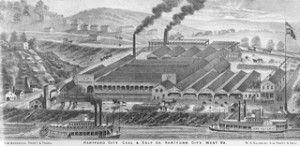WVGES: History of West Virginia Mineral Industries – Salt
From WV Geological & Economic Survey (WVGES)
Salt was the first West Virginia mineral industry to be developed. The State’s salt was being utilized long before the arrival of man. Deer and buffalo would travel to a salt spring along the Kanawha River where they could lick the salt they needed. This spot, near the town of Malden, became known as the Great Buffalo Lick, of the Kanawha Licks. Native Americans later followed the animal trails to the springs where they too could obtain their salt supply.
In 1755, a Shawnee Indian raiding party stopped at the springs with some captive pioneers from Virginia. The Shawnees boiled brines in a kettle in order to obtain salt to carry back to Ohio with them. A captive later escaped to tell the story, and in 1774, members of Andrew Lewis’ army stopped here on their way to fight Indians in Ohio at the Battle of Point Pleasant. The pioneers’ victory at the Battle of Point Pleasant began the settlement of the Kanawha Valley and an increase in the importance of the Kanawha salt springs.
In 1797, Elisha Brooks erected the first salt furnace in the Kanawha Valley at the mouth of Campbell’s Creek. He produced as much as 150 bushels of salt a day and sold it to settlers to be used for curing butter and meats. By 1808, David and Joseph Ruffner succeeded in drilling to 59 feet, where they secured a good flow of strong brine. Also in that year, the first salt was shipped west, by river, on a log raft.
A younger Ruffner brother, Tobias, suspected that a vast saline reservoir existed under the Kanawha Valley and, drilling to a depth of 410 feet, tapped an even richer brine. This discovery set off a veritable frenzy of drilling and by 1815 there were 52 furnaces in operation in the “Kanawha Salines.” In 1817, David Ruffner experimented with the use of coal in his furnaces, and soon all saltmakers had switched from wood to coal. The saltmakers formed a “trust,” the Kanawha Salt Company, in order to regulate the quality and price of salt and to discourage foreign competition. This was the first “trust” in the United States.
This cooperative helped the salt industry grow until it reached its peak in 1846, producing 3,224,786 bushels that year. At that time, the Kanawha Valley was one of the largest salt manufacturing centers in the United States. In 1861, the Kanawha Valley was flooded. By the late 1800s, because of the 1861 flood and because of Civil War destruction, the Dickinson furnace at Malden was the only survivor of the Great Kanawha River salt industry.
Although the Kanawha salt industry declined in importance after 1861, the advent of World War I brought a demand for chemical products such as chlorine and caustic acid, which could be obtained from salt brine. In 1914, the Warner-Klipstein Chemical Company opened a plant in South Charleston to produce these products. The plant is now the Westvaco Chlorine Products Corporation, and is the largest chlorine producer in the world. Other chemical industries, also based on this salt brine, have grown up in the Kanawha Valley since then.
Until World War II, only salt brine (entrapped sea water) was used for salt production. However in 1942, the Defense Plant Corporation built an electrolytic caustic soda plant at Natrium in Marshall County to extract rock salt. Water is sent down the wells to the rock salt, at depths of about 7,000 feet, where the water dissolves the salt. The salt-saturated water is then forced back to the surface where it is evaporated and the salt removed.
Today there are three principal salt-producing companies in the State, two in Marshall County and one in Tyler County. All three companies extract rock salt, most of which is sent to chemical companies along the Kanawha River. West Virginia has large reserves of rock salt at depth, providing great potentials for future use.
(Adapted from an article by Jane R. Eggleston, updated September 1996)


{ 1 comment… read it below or add one }
Here is CURRENT INFORMATION on the modern salt-based chemical industry in West Virginia.
http://www.wvcommerce.org/App_Media/Assets/publications/businessworkforce/PPG_Natrium.pdf
“AXIALL CORPORATION Created as Merger of Georgia Gulf & PPG Commodity Chemicals Business Is Completed”, As Announced on January 29, 2013
ATLANTA–(BUSINESS WIRE)–Georgia Gulf Corporation today announced that the pending merger with PPG’s commodity chemicals business has been completed, creating Axiall Corporation, effective immediately. The company will trade on the New York Stock Exchange under the ticker symbol AXLL beginning January 29, 2013.